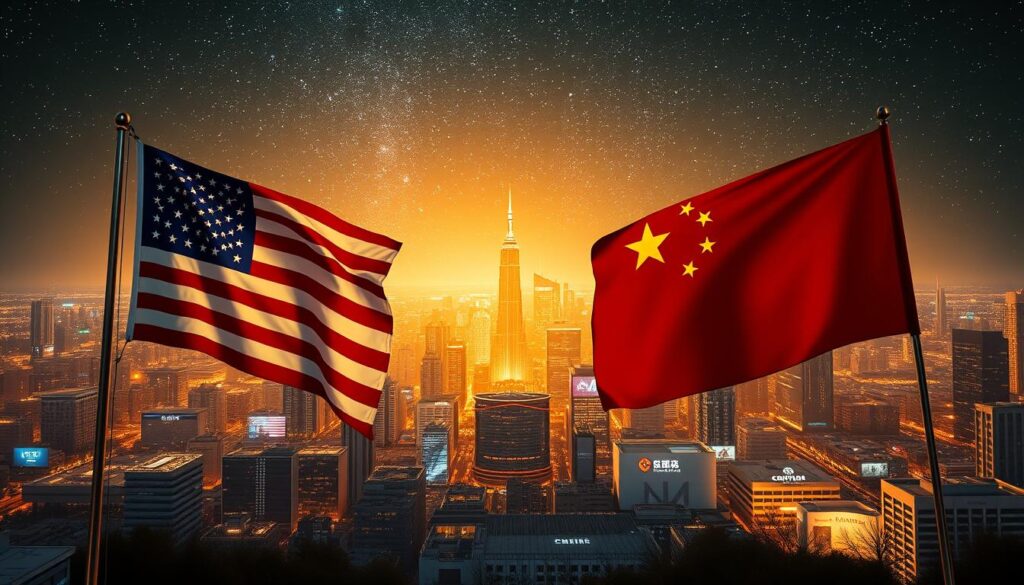“Innovation distinguishes between a leader and a follower,” said Steve Jobs. This quote captures the essence of the global contest in artificial intelligence, where innovation and strategy define the future. Today, the United States and China are at the forefront of this technology race, each leveraging distinct approaches to gain an advantage.
American companies emphasize foundational innovation, driven by democratic values and private sector investments. Meanwhile, China’s government pours massive resources into artificial intelligence, prioritizing state-backed funding and centralized control. This contrast raises a critical question: who is leading the race?
Recent developments highlight the stakes. For instance, DeepSeek, a Chinese company, has produced models rivaling those of American firms despite using fewer advanced chips1. Additionally, the Biden administration has implemented export controls to limit China’s access to critical tech components1. These measures underscore the strategic importance of policy in shaping the future of technology.
This article explores the strategies, investments, and power dynamics defining the world’s AI landscape. It examines how today’s choices will shape the digital era, comparing the approaches of the United States and China with real-world examples and data.
Key Takeaways
- Global leadership in artificial intelligence hinges on innovation and strategic investments.
- American companies focus on foundational innovation, while China emphasizes state-backed funding.
- Export controls and policy decisions play a critical role in the technology race.
- Recent advancements by Chinese firms challenge American dominance in AI development.
- The future of technology will be shaped by today’s choices in AI leadership.
Understanding the Global AI Competition

Leadership in artificial intelligence is determined by a mix of innovation, policy, and global influence. This competition is not just about technological breakthroughs but also about creating ecosystems that foster growth and collaboration. Both the united states and other nations are investing heavily in research and talent to secure their positions on the world stage.
Defining AI Leadership on the World Stage
What makes a nation a leader in artificial intelligence? Experts agree that it involves a combination of cutting-edge research, a robust talent pipeline, and supportive policy frameworks. For instance, the united states excels in foundational innovation, while other countries focus on state-backed funding and strategic partnerships2.
Public-private partnerships play a crucial role in setting international standards. These collaborations ensure that advancements in technology are accessible and scalable, benefiting the global community. For example, initiatives like AI in finance demonstrate how innovation can drive economic growth and inclusivity.
The Intersection of Innovation and Policy
Innovation and policy are deeply intertwined in the race for AI dominance. Governments worldwide are crafting regulations to balance technological advancement with ethical considerations. For example, the united states has implemented export controls to safeguard its technological edge2.
Investments in STEM education and research are also critical. Data shows that nations with higher numbers of STEM graduates tend to lead in AI development3. This highlights the importance of nurturing talent to sustain long-term growth in the technology sector.
| Country | Key Strengths | Challenges |
|---|---|---|
| United States | Foundational innovation, private sector investments | Export control enforcement, talent retention |
| China | State-backed funding, rapid development | Regulatory scrutiny, global partnerships |
As the competition intensifies, the future of artificial intelligence will be shaped by the choices made today. From policy decisions to infrastructure investments, every move counts in defining the next leader in this transformative field.
China’s Ambitious AI Strategy and Investments

China’s push to dominate artificial intelligence is backed by unprecedented state-driven strategies and massive funding. With a goal to lead globally by 2030, the nation is leveraging its centralized approach to accelerate progress in this transformative field4.
Massive Tech Investments and Government Funding
The government has committed $2.8 trillion to technology investments, focusing on sectors like semiconductors and cloud computing5. This funding supports initiatives such as the New Generation Artificial Intelligence Development Plan, which aims to make China a global leader in innovation by 20304.
State-backed funding ensures rapid development, enabling firms like Baidu and Alibaba to compete on the world stage. These companies are driving advancements in generative AI, with China filing over 38,000 patents from 2014 to 20235.
Building a Robust Pipeline of AI Talent
China produces 3.6 million STEM graduates annually, creating a deep pool of talent for its AI sector6. Aggressive education policies and incentives ensure a steady supply of skilled professionals, giving the nation a significant advantage in the global competition.
This focus on education aligns with the government’s vision to achieve 70% self-sufficiency in high-tech industries by 20255. Such initiatives highlight the synergy between policy and technology in driving progress.
Infrastructure Upgrades and Energy Initiatives
To support AI growth, China is modernizing its infrastructure, including the construction of 30,000 miles of ultra-high-voltage transmission lines6. These upgrades ensure reliable energy supply, a critical factor for data-intensive AI applications.
Investments in domestic AI chip alternatives also aim to reduce reliance on foreign tech, further solidifying China’s position in the global race6. This comprehensive approach underscores the nation’s commitment to securing power in the AI landscape.
China’s strategy contrasts sharply with the decentralized, market-driven approaches of other nations. By combining state funding, talent development, and infrastructure upgrades, the country is positioning itself as a formidable player in the world of artificial intelligence. For more insights into how AI is shaping economic growth, explore AI-driven economic growth.
America’s Response: Policies, Export Controls, and Innovation

Strategic investments and regulatory frameworks define the U.S. approach to maintaining its edge in global technology. While the united states leads in foundational innovation, challenges like leaky export controls and overregulation threaten its long-term competitiveness7.
Challenges with Export Control Enforcement
Export controls aim to safeguard critical technology, but enforcement remains inconsistent. Reports show that U.S. firms like Nvidia have created chips tailored for China, while restricted chips are rerouted through third parties7. This undermines national security and weakens the intended impact of these measures.
Experts warn that persistent loopholes could erode America’s advantage in the global competition. For instance, Singapore accounted for 18% of Nvidia’s revenue, yet only 2% of shipments originated there7. Such discrepancies highlight the need for stricter oversight.
Investments in Infrastructure and STEM Education
To counter these challenges, the united states is boosting domestic investments in infrastructure and STEM education. A proposed $500 billion project aims to build multiple data centers and modernize energy grids8. These efforts are critical for sustaining long-term growth.
STEM education is another cornerstone of America’s strategy. With budget cuts threatening key programs, experts advocate for increased funding to nurture the next generation of talent9. This aligns with the nation’s vision to remain a leader in technology.
Balancing innovation with regulation is essential. While policies like export controls are necessary, overregulation risks stifling creativity and trade secret protection. A coordinated, “play to win” approach is vital for ensuring America’s leadership remains unchallenged. For more insights, explore AI tools shaping the future.
The AI Race: Is China Winning?

Advancements in artificial intelligence are redefining the balance of power between nations. Both the united states and other countries are pushing the boundaries of technology, with breakthroughs shaping the future of global competition.
Comparing AI Capabilities
Recent datum shows that Chinese startups like DeepSeek are closing the gap with the united states. Their models rival those of top American firms, despite using fewer advanced chips1. This highlights the rapid development in China’s tech sector.
Meanwhile, the united states continues to lead in foundational innovation. However, the time gap between the two nations is narrowing, sometimes to just six months10.
Export Controls and Funding
Export restrictions have played a significant role in this race. The Biden administration has banned the export of advanced chips to Chinese firms1. Yet, this has spurred efficiency in China’s technology sector10.
Funding models also differ. While the united states relies on private sector investments, China’s government pours massive resources into artificial intelligence projects1.
Computational Resources and Energy
Energy infrastructure is another critical factor. China is upgrading its grid to support data-intensive technology, with 30,000 miles of new transmission lines. In contrast, the united states is modernizing its energy systems to sustain growth10.
These upgrades ensure both nations can handle the demands of advanced artificial intelligence applications.
Implications for the Future
The competition is reshaping the digital landscape. As Chinese firms like DeepSeek advance, the united states must adapt to maintain its advantage1.
This race is not just about technology but also about securing long-term economic and strategic power. The choices made today will define the leader of tomorrow.
Technological Innovations: U.S. vs. China in AI Development

Breakthroughs in AI are redefining the boundaries of technological leadership. Both the united states and other nations are pushing the limits of innovation, with cutting-edge models and research shaping the future of global competition.
Breakthrough Models and Research Advances
Silicon Valley giants like OpenAI, Google, and Meta have introduced groundbreaking models such as GPT-4, PaLM, and LLaMA. These models set new industry standards, showcasing the united states‘ dominance in foundational technology11.
Meanwhile, Chinese firms like DeepSeek are closing the gap. Their R1 model matches or surpasses Western counterparts in performance and cost-effectiveness, despite using fewer resources11. This highlights the rapid development in China’s tech sector.
Open-Source Versus Proprietary Ecosystems
The U.S. emphasizes open-source ecosystems, fostering collaboration and global influence. For example, Meta’s LLaMA model is widely accessible, encouraging researcher participation and accelerating innovation11.
In contrast, China focuses on proprietary systems, ensuring tighter control over technology and intellectual property. This approach supports rapid commercialization but limits global collaboration12.
| Aspect | United States | China |
|---|---|---|
| Research Focus | Foundational innovation | Cost-effective optimization |
| Ecosystem | Open-source | Proprietary |
| Resource Allocation | High computational power | Efficient resource use |
Both nations are leveraging their strengths to maintain power in the global world of AI. For deeper insights into how these advancements are shaping the competition, explore AI advancements in the U.S. and.
The Role of Energy and Infrastructure in AI Progress

Reliable energy and modern infrastructure are the backbone of technological advancements in artificial intelligence. Without robust systems, even the most innovative breakthroughs face limitations. Both the united states and other nations are grappling with these challenges as they strive to lead in the global competition.
Energy Supply and Grid Modernization Challenges
Scaling AI systems requires massive computational power, which in turn demands a steady and efficient energy supply. China has invested $442 billion in grid modernization, including 30,000 miles of ultra-high-voltage transmission lines13. This ensures their data centers can handle the growing demands of technology.
In contrast, the united states struggles with an outdated grid and stalled domestic projects. This lag in infrastructure could hinder its ability to maintain a advantage in the global race for AI leadership13.
Semiconductor manufacturing, a critical component of AI development, is also heavily dependent on energy. Efficient production processes reduce costs and improve access to advanced technology. China’s focus on modernizing its grid supports its semiconductor industry, while the U.S. faces challenges in matching this effort13.
| Aspect | United States | China |
|---|---|---|
| Grid Modernization | Outdated infrastructure, stalled projects | $442 billion investment, 30,000 miles of UHV lines |
| Energy Efficiency | Challenges in semiconductor production | Efficient manufacturing processes |
| Data Center Capacity | Limited by grid constraints | Expanding to meet AI demands |
The interdependency between energy resources and AI innovation cannot be overstated. Without reliable infrastructure, even the best technology faces significant hurdles. These differences in investment and development will shape the future of global AI leadership.
National Security Implications and Geopolitical Rivalry
National security concerns are escalating as export control vulnerabilities threaten global tech dominance. Weaknesses in enforcement systems allow adversaries to access advanced hardware, undermining efforts to maintain strategic leadership14.
Export Control Evasion and Security Concerns
Export restrictions aim to safeguard critical tech, but enforcement remains inconsistent. Reports show that restricted chips are rerouted through third parties, bypassing controls14. This leakage of advanced components poses significant risks to security and economic competitiveness.
Foreign companies and regional resellers play a key role in these diversions. For example, Singapore accounted for 18% of Nvidia’s revenue, yet only 2% of shipments originated there14. Such discrepancies highlight the need for stricter oversight.
“Export controls are a critical tool, but without robust enforcement, they become ineffective.”
Strategic Implications for U.S. Global Leadership
Compromised security not only affects defense but also threatens global alliances. The united states must address these vulnerabilities to maintain its position as a superpower15.
China’s state-backed efforts to dominate exports and standards further complicate the landscape. Their focus on self-sufficiency in semiconductor production challenges U.S. leadership16.
- Limited resources and antiquated tracking systems hinder enforcement efforts.
- Collaborative measures with allies are essential to secure supply chains.
- Improved regulatory frameworks are urgently needed to protect national interests.
As the competition intensifies, the united states must adapt to safeguard its advantage. Strengthening export controls and fostering global partnerships will be key to securing the future of tech innovation16.
Key Challenges and Future Outlook for AI Leadership
Navigating the complexities of global leadership in technology requires addressing ethical, regulatory, and competitive challenges. As nations strive to dominate this transformative field, they must confront dilemmas that could shape the next phase of the race.
Ethical and Regulatory Hurdles
Deploying advanced systems raises significant ethical questions. Issues like data privacy, algorithmic bias, and intellectual property theft are at the forefront of debates. For instance, China’s “Interim Measures for the Management of Generative Artificial Intelligence Services” sets a regulatory benchmark, but enforcement remains inconsistent17.
In democratic regimes, balancing innovation with ethical considerations is equally challenging. The united states faces pressure to implement robust frameworks that protect user rights without stifling creativity18.
Competitive Pressures and Strategic Investments
Both nations are investing heavily to maintain their edge. China’s private investment in generative systems surged from $650 million in 2023 to $3.15 billion in 202417. Meanwhile, the united states has committed over $12 billion to research and development over the past five years18.
These investments highlight the intense competition to lead in this field. However, without strategic reforms, existing inequities in global leadership could deepen.
National Security and Geopolitical Rivalry
Security concerns are escalating as export control vulnerabilities threaten dominance. Leakage of advanced components through third parties undermines efforts to safeguard critical technology17.
China’s focus on self-sufficiency in semiconductor production challenges U.S. leadership. This evolving rivalry intensifies the need for decisive policy measures to secure the future of innovation18.
| Challenge | United States | China |
|---|---|---|
| Ethical Regulation | Balancing innovation with user rights | Setting benchmarks with inconsistent enforcement |
| Investment Focus | $12 billion in R&D over five years | $3.15 billion in generative AI in 2024 |
| Security Measures | Export control vulnerabilities | Push for self-sufficiency in semiconductors |
As the world moves forward, addressing these challenges will be critical. Strategic investments in regulation, ethics, and talent development will shape the next phase of global leadership in this transformative field.
Conclusion
Global leadership in technology hinges on strategic investments and innovation. State-driven initiatives in one country contrast sharply with private sector efforts in another, shaping the future of power dynamics19. Massive funding and infrastructure upgrades are critical tools for maintaining a competitive edge.
Recent data shows that investment in research and development has surged, with one nation committing over $15 billion in 202420. This highlights the urgency for policymakers to act decisively. Strengthening export controls and fostering collaboration are essential steps to secure long-term leadership.
Ethical and regulatory foresight will mold a responsible digital future. Balancing innovation with security ensures sustainable growth. Proactive measures today will define the world of tomorrow. For insights into how technology drives economic growth, explore AI-driven opportunities.
FAQ
What defines leadership in artificial intelligence globally?
How is China advancing its artificial intelligence capabilities?
What challenges does the United States face in maintaining its AI edge?
How do energy and infrastructure impact AI development?
What are the national security implications of the AI competition?
What are the key challenges for future AI leadership?
Source Links
- DeepSeek and the shifting tides of the US-China AI race
- Strategic Reorientation on AI Competition with China
- The global AI race: Is China catching up to the US?
- The Great AI Race: China, Deepseek, and the Global Quest for Supremacy – and its risks
- Quick Question Tuesday, Part 6: Is China Winning the AI Race?
- The AI Arms Race: DeepSeek Vs. OpenAI And The Battle For Global AI Dominance
- DeepSeek, Huawei, Export Controls, and the Future of the U.S.-China AI Race
- Containment Can’t Win the U.S.-China Tech Race Alone
- Begun, the US vs. China AI Race Has
- The west is already losing the AI arms race | Larry Elliott
- China vs. U.S. in AI: Who’s Winning the AI Race?
- The American Playbook to Win the AI Race With China – American Edge Project
- China’s AI future in a quest for geopolitical, computing and electric power
- The AI Superpower Rivalry: A Zero-sum Game Between China and the United States?
- There can be no winners in a US-China AI arms race
- AI Rivalries: Redefining Global Power Dynamics
- China And AI In 2025: What Global Executives Must Know To Stay Ahead
- Stakes Rising In The US-China AI Race
- What DeepSeek’s breakthrough says (and doesn’t say) about the ‘AI race’ with China
- Is China Really Outpacing the U.S. in the AI Race? A Deep Dive into the Global AI Landscape







